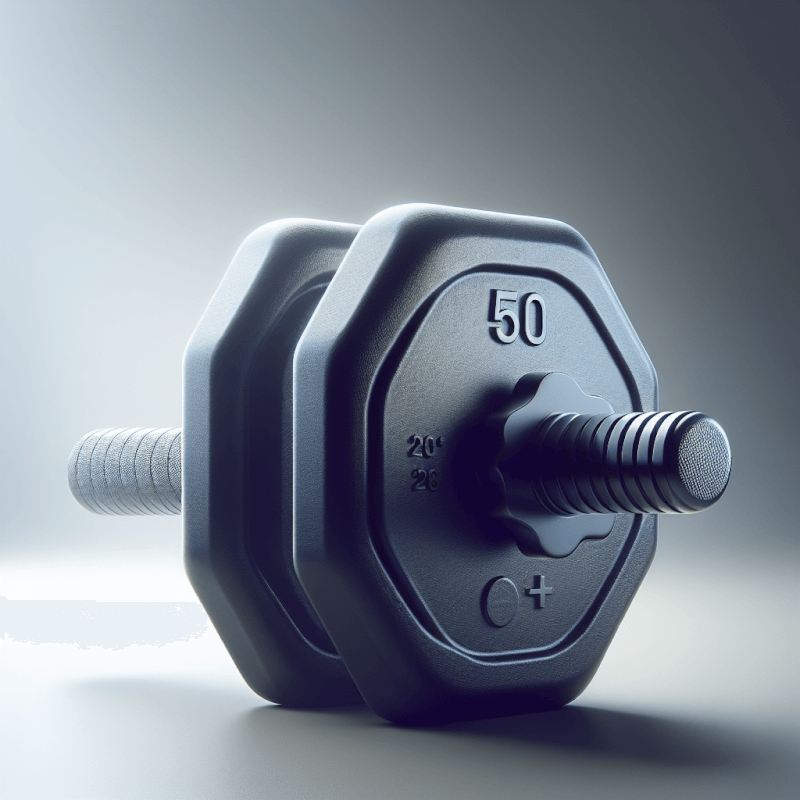Are you over 50 and looking for an effective way to stay fit and healthy? Look no further! In this article, we will be discussing the benefits of dumbbell workouts specifically designed for individuals over 50. These workouts are not only great for improving strength and muscle tone, but they can also help in maintaining bone density and promoting overall mobility. So, whether you’re a fitness enthusiast or new to exercising, grab a set of dumbbells and get ready to embark on a journey towards improved fitness and vitality!

Benefits of Dumbbell Workouts for Over 50
Strength and Muscle Building
One of the key benefits of incorporating dumbbell workouts into your fitness routine after the age of 50 is the ability to build strength and muscle. As we age, our muscle mass naturally declines, which can lead to a decrease in overall strength and mobility. By engaging in regular dumbbell exercises, you can counteract this muscle loss and maintain or even increase your muscle tone and strength. Strengthening your muscles is not only important for everyday activities, but it can also improve your balance and reduce your risk of falls or injuries.
Improved Bone Density
Another advantage of dumbbell workouts for individuals over 50 is the potential to improve bone density. As we age, our bones become more susceptible to osteoporosis and fractures. Weight-bearing exercises, such as dumbbell workouts, help to stimulate bone growth and increase bone density, which can reduce the risk of osteoporosis and improve overall bone health. By integrating dumbbell exercises into your routine, you can effectively lower your chances of developing osteoporosis and maintain strong, healthy bones.
Increased Metabolism
Maintaining a healthy metabolism becomes increasingly challenging as we age. However, incorporating dumbbell workouts into your fitness regimen can help rev up your metabolism and keep it running efficiently. Dumbbell exercises engage multiple muscle groups, which can increase your heart rate and boost your metabolism both during and after your workout. This increased metabolic rate can lead to more efficient calorie burning and help you maintain a healthy weight and body composition.
Enhanced Balance and Stability
Maintaining good balance and stability is crucial as we age to prevent falls and maintain an active lifestyle. Dumbbell workouts require stability and controlled movements, which can greatly improve your balance and coordination. By strengthening the muscles responsible for balance, such as the core and leg muscles, you can enhance your stability and reduce the risk of falls. Regular dumbbell exercises also train your body to maintain proper alignment and posture, further improving your overall balance and stability.
Improved Joint Health
Joint health becomes increasingly important as we age, and dumbbell workouts can play a significant role in maintaining healthy joints. While high-impact exercises can put excess stress on the joints, dumbbell exercises are low-impact and provide a safer alternative for individuals over 50. The controlled movements and range of motion involved in dumbbell exercises can help lubricate the joints, reduce stiffness, and promote overall joint health. By incorporating dumbbell workouts into your routine, you can keep your joints healthy and mobile, allowing you to stay active and pain-free.
Enhanced Cognitive Function
Engaging in regular physical activity is not only beneficial for your body but also for your brain. Dumbbell workouts can help enhance cognitive function, specifically in individuals over the age of 50. Exercise increases blood flow to the brain, which promotes the growth of new brain cells and strengthens neural connections. Additionally, physical activity releases endorphins, which can improve mood and reduce the risk of cognitive decline and mental health issues. By including dumbbell exercises in your routine, you can experience improved cognitive function and mental well-being.
Stress Relief and Mental Well-being
In addition to the cognitive benefits, dumbbell workouts can also provide significant stress relief and contribute to overall mental well-being. Regular exercise has been shown to decrease symptoms of stress, anxiety, and depression, while boosting mood and promoting relaxation. Dumbbell workouts allow you to focus on the present moment, providing a mental break from daily stressors and worries. Whether you choose to do your dumbbell workouts at home, in a gym, or outdoors, the combination of physical activity and the release of endorphins can significantly improve your mental state and overall well-being.
Choosing the Right Dumbbells for Over 50s
Considerations for Weight Selection
When choosing dumbbells for your workouts after the age of 50, it’s important to consider the appropriate weight selection. As a general guideline, it’s recommended to start with lighter weights and gradually increase the resistance as your strength improves. This approach allows you to focus on proper form and technique while minimizing the risk of injury. It’s also essential to listen to your body and avoid pushing yourself beyond your limits. If you’re unsure about the appropriate weight selection, consult with a fitness professional who can guide you based on your individual fitness level and goals.
Types of Dumbbells
There are several types of dumbbells available, each with its own advantages and considerations. The most common types include adjustable dumbbells, hex dumbbells, neoprene dumbbells, and rubber-coated dumbbells. Understanding the differences between these types can help you choose the right dumbbells for your needs.
Adjustable Dumbbells
Adjustable dumbbells are ideal for those with limited space or who prefer a variety of weight options. These dumbbells consist of a handle and removable weight plates, allowing you to adjust the weight according to your desired resistance. Adjustable dumbbells are versatile and can be cost-effective in the long run, as they eliminate the need to purchase multiple pairs of fixed-weight dumbbells.
Hex Dumbbells
Hex dumbbells feature a hexagonal shape, which prevents them from rolling away and provides stability during exercises. They are typically made of solid cast iron and have a durable construction. Hex dumbbells are a popular choice for strength training and can be used for a wide range of exercises. However, they can take up more space compared to adjustable dumbbells and may require separate purchases to achieve different weight levels.
Neoprene Dumbbells
Neoprene dumbbells are coated with a layer of neoprene, a soft and non-slip material, which provides a comfortable and secure grip. These dumbbells are available in a variety of vibrant colors and are popular for aerobic exercises, as well as for individuals with joint issues. Neoprene dumbbells typically come in fixed weights, so you may need to purchase multiple pairs to accommodate different resistance levels.
Rubber Coated Dumbbells
Rubber-coated dumbbells have a protective rubber coating that helps prevent damage to floors and equipment, making them an excellent choice for home workouts. The rubber coating also provides a comfortable grip and reduces noise during exercises. Like neoprene dumbbells, rubber-coated dumbbells usually come in fixed weight options, so you may need to purchase multiple pairs to meet your resistance needs.
When selecting the right dumbbells for your workouts, consider your space limitations, budget, and specific exercise preferences to make an informed decision.
Warm-up and Safety Guidelines
Importance of Warm-up
Before embarking on any exercise routine, it’s crucial to prioritize warm-up exercises. Warming up helps prepare your body for the upcoming workout by increasing blood flow, loosening up the muscles, and improving joint mobility. For individuals over 50, a proper warm-up is especially important to prevent injuries and ensure a safe and effective workout. Spending 5 to 10 minutes engaging in light cardio activities such as brisk walking or cycling can gradually raise your heart rate and warm up your muscles, preparing them for the upcoming dumbbell exercises.
Dynamic Stretches
In addition to a cardiovascular warm-up, incorporating dynamic stretches into your warm-up routine can further enhance your mobility and flexibility. Dynamic stretches involve fluid movements that stretch the muscles and improve their range of motion. Examples of dynamic stretches include arm circles, leg swings, and torso twists. Performing these stretches before your dumbbell workout can help activate the muscles and joints, reducing the risk of injury and optimizing your performance.
Proper Form and Technique
Maintaining proper form and technique throughout your dumbbell exercises is crucial for preventing injuries and maximizing the benefits of your workout. When using dumbbells, remember to stand with a stable base and engage your core muscles for stability. Keep your spine neutral and avoid excessive arching or rounding of your back. During each exercise, focus on the targeted muscle group and ensure that you’re moving smoothly and under control. If you’re unsure about the proper form, it’s recommended to seek guidance from a qualified fitness professional or watch instructional videos to ensure you’re performing the exercises correctly.
Breathing Techniques
Proper breathing techniques can greatly enhance your dumbbell workouts and provide additional support for your muscles and joints. When performing resistance exercises, exhale during the exertion phase, or when you’re lifting the dumbbells against gravity. This exhalation can help stabilize your core and provide additional power to your movements. Inhale during the relaxation phase, or when you’re returning to the starting position. Focusing on your breathing can help maintain control and rhythm throughout the exercises, promoting efficient oxygen exchange and enhancing your overall performance.
Safety Considerations
Safety should always be a top priority during any exercise routine, especially for individuals over 50. Some safety considerations to keep in mind during your dumbbell workouts include:
- Starting with lighter weights and gradually progressing to heavier ones.
- Ensuring that the dumbbells are securely gripped and free from any defects.
- Avoiding quick and jerky movements, as these can strain the muscles or cause joint injuries.
- Using a sturdy and non-slip exercise mat or flooring to prevent falls or accidents.
- Keeping a clear workout area and removing any potential hazards or obstructions.
By following these safety guidelines, you can minimize the risk of injuries and create a safe environment for your dumbbell workouts.
Listening to Your Body
Listening to your body is crucial when engaging in any exercise routine, but particularly for individuals over 50. Pay attention to any feelings of pain, discomfort, or excessive fatigue during your dumbbell workouts. These sensations could be an indication of improper form, overexertion, or an underlying health issue. If you experience any discomfort, it’s important to stop the exercise and seek guidance from a healthcare professional or fitness expert. Remember, it’s better to take a break or modify an exercise than to push through pain and risk further injury.
Upper Body Dumbbell Exercises
Dumbbell Bicep Curls
Dumbbell bicep curls are an excellent exercise for targeting the muscles in your arms. To perform this exercise, stand with your feet shoulder-width apart and hold a dumbbell in each hand, palms facing forward. Keep your upper arms stationary and bring the dumbbells up towards your chest by bending your elbows. Slowly lower the dumbbells back down to the starting position and repeat for the desired number of repetitions. Dumbbell bicep curls can help strengthen your biceps and improve the appearance and functionality of your arms.
Dumbbell Shoulder Press
The dumbbell shoulder press is a compound exercise that targets the deltoid muscles in your shoulders, as well as the triceps and upper back muscles. To perform this exercise, sit on a bench or stand with your feet shoulder-width apart and hold a dumbbell in each hand, elbows bent at a 90-degree angle. Press the dumbbells upward until your arms are fully extended overhead, then slowly lower them back down to the starting position. Dumbbell shoulder presses can help improve shoulder strength and stability, making everyday activities such as lifting or reaching overhead easier and safer.
Dumbbell Chest Press
The dumbbell chest press is an effective exercise for targeting the muscles in your chest, shoulders, and triceps. To perform this exercise, lie on a flat bench with a dumbbell in each hand, palms facing forward. Start with your arms bent at a 90-degree angle, elbows level with your chest. Push the dumbbells upward until your arms are fully extended, then lower them back down to the starting position. Dumbbell chest presses can help strengthen your chest muscles, improve upper body strength, and enhance your overall posture.
Dumbbell Tricep Extensions
Dumbbell tricep extensions are a great exercise for isolating and strengthening the tricep muscles at the back of your arms. Stand with your feet hip-width apart and hold a dumbbell with both hands, palms facing upward. Raise the dumbbell overhead, keeping your upper arms close to your head. Slowly lower the dumbbell behind your head, bending your elbows and feeling a stretch in your triceps. Extend your arms back up to the starting position and repeat for the desired number of repetitions. Dumbbell tricep extensions can help improve the definition and strength of your tricep muscles, allowing you to perform everyday activities with ease.
Dumbbell Bent-Over Rows
Dumbbell bent-over rows are a compound exercise that targets multiple muscles in your upper back, including the rhomboids, trapezius, and latissimus dorsi. Stand with your feet shoulder-width apart, bend your knees slightly, and hinge forward at the hips while keeping your back straight. Hold a dumbbell in each hand, palms facing your body. Maintain a neutral spine and pull your elbows up, squeezing the shoulder blades together as you bring the dumbbells toward your chest. Lower the dumbbells back down and repeat for the desired number of repetitions. Dumbbell bent-over rows can help improve your posture, strengthen your upper back muscles, and enhance overall back stability.
Dumbbell Flyes
Dumbbell flyes target the muscles in your chest and shoulders while also engaging your back and arm muscles. Lie on a flat bench with a dumbbell in each hand, extended upward above your chest, palms facing each other. Keeping a slight bend in your elbows, lower the dumbbells out to the sides until you feel a stretch in your chest. Bring the dumbbells back up to the starting position by squeezing your chest muscles and keeping your arms slightly bent. Repeat for the desired number of repetitions. Dumbbell flyes can help increase chest muscle activation, improve upper body strength, and enhance your overall chest development.

Lower Body Dumbbell Exercises
Dumbbell Squats
Dumbbell squats are a compound exercise that targets multiple muscle groups in your lower body, including your quadriceps, hamstrings, and glutes. Stand with your feet shoulder-width apart, holding a dumbbell in each hand, palms facing inward. Bend your knees and lower your body as if you’re sitting back into a chair, keeping your chest up and your core engaged. Lower until your thighs are parallel to the ground, then push through your heels to return to the starting position. Dumbbell squats can help strengthen your lower body, improve balance, and increase mobility in your hips and knees.
Dumbbell Lunges
Dumbbell lunges are an effective exercise for targeting your quadriceps, hamstrings, and glutes, while also improving your balance and stability. Start by standing with your feet hip-width apart, holding a dumbbell in each hand, palms facing your body. Take a step forward with your right foot and lower your body until both knees are bent at a 90-degree angle. Push through your front heel to return to the starting position, then repeat on the other side. Dumbbell lunges can help strengthen your lower body, enhance your coordination, and increase your overall leg power.
Dumbbell Deadlifts
Dumbbell deadlifts are a compound exercise that primarily targets your glutes, hamstrings, and lower back, while also engaging your core and upper body muscles. Stand with your feet hip-width apart and hold a dumbbell in each hand, palms facing inward. Hinge at your hips, push your glutes backward, and lower the dumbbells to mid-shin level while keeping a slight bend in your knees. Engage your glutes and hamstrings to stand back up, pushing your hips forward and squeezing your glutes at the top of the movement. Dumbbell deadlifts can help improve your overall posterior chain strength, increase hip mobility, and enhance your overall stability.
Dumbbell Step-Ups
Dumbbell step-ups target your glutes, quadriceps, and hamstrings, while also engaging your core and improving your balance. Start by standing in front of a sturdy bench or step with a dumbbell in each hand, palms facing your body. Step your right foot onto the bench, driving through your heel to lift your body up. Straighten your right leg and bring your left foot up to meet the right on top of the bench. Step back down with your left foot, then your right, and repeat on the other side. Dumbbell step-ups can help increase leg strength, improve balance, and enhance stability in your lower body.
Dumbbell Calf Raises
Dumbbell calf raises are an excellent exercise for targeting your calf muscles, which are responsible for ankle stability and propelling you forward during walking and running. Stand with your feet hip-width apart, holding a dumbbell in each hand, palms facing inward. Raise your heels off the ground as high as you can while keeping your body upright and your core engaged. Hold the contraction at the top for a second before slowly lowering your heels back down to the starting position. Dumbbell calf raises can help strengthen and tone your calf muscles, improve ankle stability, and enhance overall lower body strength.
Dumbbell Glute Bridges
Dumbbell glute bridges are a great exercise for targeting your glutes and hamstrings, while also activating your core and lower back muscles. Lie on your back with your knees bent and your feet flat on the ground, hip-width apart. Hold a dumbbell on your hips, palms facing downward. Press your heels into the ground and squeeze your glutes, lifting your hips and lower back off the ground until your body forms a straight line from your knees to your shoulders. Hold the contraction for a second at the top before slowly lowering your hips back down to the starting position. Dumbbell glute bridges can help strengthen your glutes, improve hip mobility, and enhance overall lower body stability.
Core Dumbbell Exercises
Dumbbell Russian Twists
Dumbbell Russian twists target your obliques, which are the muscles on the sides of your abdomen. Sit on the ground with your knees bent and your feet flat on the floor. Hold a dumbbell with both hands, propping your feet up off the ground. Twist your torso to the right, bringing the dumbbell to the right side of your body. Pause briefly, then twist to the left side, bringing the dumbbell to the left. Continue alternating sides for the desired number of repetitions. Dumbbell Russian twists can help strengthen your obliques, improve core stability, and enhance rotational power.
Dumbbell Plank Rows
Dumbbell plank rows are a challenging exercise that targets multiple muscles in your core, upper back, and arms. Start in a high plank position with your hands gripping a pair of dumbbells, wrists directly under your shoulders. Spread your feet wide for stability. Maintaining a strong plank position, row one dumbbell up towards your chest, keeping your elbow close to your body. Lower the dumbbell back down and repeat on the other side. Dumbbell plank rows can help strengthen your core, improve upper body stability, and enhance overall muscular endurance.
Dumbbell Woodchoppers
Dumbbell woodchoppers are an effective exercise for targeting your obliques, core muscles, and shoulder muscles. Stand with your feet shoulder-width apart, holding a dumbbell with both hands in front of your body. Bring the dumbbell diagonally across your body and up towards your opposite shoulder, while rotating your torso. Keep your core engaged and your hips stable throughout the movement. Slowly lower the dumbbell back to the starting position and repeat on the other side. Dumbbell woodchoppers can help strengthen your obliques, improve rotational power, and enhance overall core stability.
Dumbbell Side Bends
Dumbbell side bends target the muscles on the sides of your core, specifically the obliques. Stand with your feet hip-width apart and hold a dumbbell in one hand, palm facing inward. Keep your core engaged and maintain a neutral spine as you slowly lower the dumbbell towards your side, feeling a stretch in your oblique. Use your oblique muscles to lift the dumbbell back up to the starting position and repeat on the other side. Dumbbell side bends can help strengthen your obliques, improve lateral stability, and enhance your overall core strength.
Dumbbell Sit-Ups
Dumbbell sit-ups are a challenging exercise that targets your rectus abdominis, which is commonly referred to as the “six-pack” muscles. Lie on your back with your knees bent and your feet flat on the ground, holding a dumbbell against your chest with both hands. Engage your core muscles and sit up, lifting your upper body off the ground while keeping your lower back pressed firmly into the mat. Slowly lower your upper body back down to the starting position and repeat for the desired number of repetitions. Dumbbell sit-ups can help strengthen your abdominal muscles, improve core stability, and enhance overall core endurance.
Dumbbell Pallof Press
The dumbbell Pallof press is an effective exercise for targeting your core muscles, specifically the deep stabilizers. Stand perpendicular to a cable machine or an anchored resistance band. Grasp the handle or band with both hands and bring it to your chest, facing your side. Keep your feet shoulder-width apart and brace your core. Extend your arms forward, pressing the dumbbell perpendicular to your body. Hold for a few seconds, then return to the starting position. Dumbbell Pallof presses can help strengthen your core, improve overall stability, and enhance rotational power.

Cardio and Full Body Dumbbell Workouts
Dumbbell HIIT (High-Intensity Interval Training)
Dumbbell high-intensity interval training (HIIT) involves performing short bursts of high-intensity exercises followed by brief recovery periods. This type of workout can effectively elevate your heart rate, burn calories, and improve cardiovascular fitness. A sample dumbbell HIIT workout could include exercises such as dumbbell thrusters, dumbbell burpees, and dumbbell mountain climbers. Perform each exercise for 30 seconds to 1 minute, taking minimum breaks in between. Repeat the circuit for several rounds, gradually increasing the intensity and duration as your fitness level improves. Dumbbell HIIT workouts are time-efficient and can provide a well-rounded cardiovascular and full-body strength training session.
Dumbbell Circuit Training
Dumbbell circuit training involves performing a series of exercises one after another, with minimal rest in between. This form of workout can effectively target multiple muscle groups while keeping your heart rate elevated. Design your own circuit using a combination of upper body, lower body, and core exercises. For example, a dumbbell circuit workout could include exercises such as dumbbell squats, dumbbell rows, dumbbell push-ups, and dumbbell planks. Perform each exercise for a set number of repetitions or time, then move on to the next exercise without resting. Complete the circuit for several rounds, adjusting the weights and intensity to challenge your fitness level. Dumbbell circuit training workouts can provide a full-body workout, improve muscular endurance, and boost cardiovascular fitness.
Dumbbell Tabata
Dumbbell Tabata workouts involve performing an exercise at high intensity for 20 seconds, followed by 10 seconds of rest. This cycle is repeated for a total of 8 rounds, resulting in a 4-minute workout per exercise. Choose a variety of dumbbell exercises targeting different muscle groups and alternate between them to create a Tabata workout. For example, you could perform exercises such as dumbbell squat jumps, dumbbell push presses, dumbbell renegade rows, and dumbbell Russian twists. This type of workout increases cardiovascular fitness, burns calories, and improves muscular endurance. Remember to choose weights that allow you to maintain proper form and challenge your muscles within the designated time frame.
Dumbbell Complexes
Dumbbell complexes involve performing a series of exercises back to back without putting the weights down. This type of workout can effectively improve strength, cardiovascular endurance, and muscular conditioning. Choose a set of dumbbell exercises that target different muscle groups and perform them consecutively with minimal rest in between. For example, a dumbbell complex workout could include exercises such as dumbbell squats, dumbbell lunges, dumbbell push presses, and dumbbell bent-over rows. Perform a designated number of repetitions for each exercise before moving on to the next. Complete multiple rounds of the complex, gradually increasing the intensity and weight as your fitness level improves. Dumbbell complexes provide a challenging and time-efficient full-body workout that can help improve overall fitness and strength.
Dumbbell CrossFit-inspired Workouts
CrossFit-inspired workouts can be adapted to include dumbbell exercises and provide a high-intensity, full-body workout. These workouts typically involve a combination of functional movements performed at a fast pace. Choose a variety of dumbbell exercises that mimic the movements found in a CrossFit workout, such as dumbbell thrusters, dumbbell snatches, dumbbell box step-ups, and dumbbell burpees. Perform the exercises for a designated number of repetitions or time, with minimal rest in between. Complete several rounds of the circuit, gradually increasing the intensity and weight as your fitness level improves. Dumbbell CrossFit-inspired workouts are demanding and can improve cardiovascular fitness, build strength, and enhance overall athletic performance.
Dumbbell Cardio Blast
A dumbbell cardio blast workout combines cardiovascular exercises with dumbbell exercises to create a high-intensity, calorie-burning workout. Begin with a dynamic warm-up to prepare your body for the upcoming workout. Choose a variety of cardio exercises, such as jumping jacks, high knees, and mountain climbers, and alternate them with dumbbell exercises, such as dumbbell squat jumps, dumbbell burpees, and dumbbell renegade rows. Perform each exercise for a set number of repetitions or time, with minimal rest in between. Complete several rounds of the circuit, gradually increasing the intensity and challenge as your fitness level improves. Dumbbell cardio blast workouts provide a full-body workout, improve cardiovascular fitness, and help burn calories.
Designing an Effective Dumbbell Workout Routine
Determining Frequency and Duration
When designing a dumbbell workout routine for individuals over 50, it’s important to consider your overall fitness level, goals, and schedule. Aim for at least 2-3 days of resistance training per week, allowing for adequate rest and recovery between sessions. Each dumbbell workout session should last approximately 45 minutes to an hour, including warm-up and cool-down periods. This duration allows enough time to target multiple muscle groups and engage in proper form and technique without overexerting yourself. Keep in mind that consistency and gradual progression are key to achieving long-term results.
Balancing Upper and Lower Body Exercises
To ensure a balanced and well-rounded workout routine, it’s important to incorporate both upper and lower body dumbbell exercises. Upper body exercises, such as dumbbell bicep curls, dumbbell shoulder presses, and dumbbell chest presses, target the muscles in your arms, shoulders, and chest. Lower body exercises, such as dumbbell squats, dumbbell lunges, and dumbbell deadlifts, target the muscles in your legs and glutes. By including a variety of upper and lower body exercises in your routine, you can effectively strengthen and tone your entire body.
Incorporating Cardiovascular Training
In addition to resistance training with dumbbells, it’s essential to incorporate cardiovascular training into your workout routine. Cardiovascular exercises, such as brisk walking, cycling, or swimming, can improve heart health, increase endurance, and promote weight management. Aim for at least 150 minutes of moderate-intensity cardiovascular exercise per week, or 75 minutes of vigorous-intensity exercise, in addition to your dumbbell workouts. You can split this time into multiple sessions throughout the week to make it more manageable and enjoyable.
Progressive Overload
To continue making progress and challenging your muscles, it’s important to incorporate progressive overload in your dumbbell workouts. Progressive overload involves gradually increasing the intensity, weight, or volume of your exercises over time. This can be achieved by increasing the weight of your dumbbells, performing additional repetitions or sets, or decreasing the rest periods between exercises. By progressively overloading your muscles, you can stimulate further strength and muscle gains. However, it’s important to progress gradually and listen to your body’s limits to avoid injury or overexertion.
Rest and Recovery
Rest and recovery are crucial components of any effective workout routine, especially for individuals over 50. Allow your body time to recover and rebuild between resistance training sessions by incorporating rest days into your weekly schedule. On these rest days, focus on low-impact activities such as gentle stretching, yoga, or light cardio to promote muscle recovery and flexibility. Additionally, aim for 7-9 hours of quality sleep per night to support optimal recovery and overall health.
Varying Exercise Selection
To maintain motivation and prevent workout plateaus, it’s important to vary your exercise selection within your dumbbell workout routine. This can involve incorporating different dumbbell exercises, changing your grip or stance, or trying new workout formats such as HIIT or circuit training. By continually challenging your muscles in different ways, you can prevent boredom, target different muscle fibers, and stimulate further strength and muscle gains.
Monitoring and Adjusting Intensity
It’s important to regularly monitor and adjust the intensity of your dumbbell workouts to ensure they remain challenging and effective. Pay attention to how your muscles feel during and after each workout, as well as your overall energy levels. If a particular exercise or weight becomes too easy, consider increasing the weight or trying a more advanced variation. On the other hand, if you experience excessive fatigue or joint discomfort, consider reducing the weight or modifying the exercise to better suit your abilities. Regularly reassessing and adjusting the intensity of your workouts will help you continue progressing and achieving your fitness goals safely and effectively.

Tips for Success and Injury Prevention
Gradual Progression
When starting a dumbbell workout routine, it’s important to progress gradually to prevent injury and ensure adequate adaptation of your muscles and joints. Begin with lighter weights and focus on mastering proper form and technique. Gradually increase the weight or resistance as your strength improves, taking care to listen to your body and avoid overexertion. Set realistic goals and be consistent with your workouts to achieve long-term success.
Proper Nutrition and Hydration
Proper nutrition and hydration are vital components of any successful workout routine. Ensure you consume a balanced diet that includes a variety of protein, carbohydrates, healthy fats, and plenty of fruits and vegetables to support muscle growth and recovery. Stay adequately hydrated by drinking water throughout the day, especially before, during, and after your workouts. Proper nutrition and hydration will provide your body with the fuel it needs to perform at its best and recover optimally.
Stretching and Cool Down
Incorporating stretching exercises and a proper cool down into your post-workout routine is essential for minimizing muscle soreness and improving flexibility. After each dumbbell workout, spend 10-15 minutes performing static stretches that target the major muscle groups you worked. Focus on gentle stretching and avoid bouncing or forcing the stretch. Cooling down with light cardiovascular exercises, such as walking or cycling, can help gradually lower your heart rate and promote proper recovery.
Avoiding Overtraining
While consistency is important, it’s equally crucial to avoid overtraining, especially for individuals over 50. Overtraining occurs when you exceed your body’s ability to recover from exercise, leading to fatigue, decreased performance, and increased injury risk. Listen to your body’s signals and adjust your workout intensity, duration, or frequency as needed. Incorporate rest days and lower-intensity activities into your routine to allow your muscles and joints to recover and repair.
Seeking Professional Guidance
If you’re new to dumbbell workouts or have specific health concerns, it’s advisable to seek professional guidance from a certified personal trainer or fitness expert. They can assess your fitness level, provide guidance on proper form and technique, and create a personalized workout plan that aligns with your goals and limitations. Professional guidance ensures you’re performing the exercises correctly, minimizing the risk of injury and maximizing your results.
Modifying Exercises for Joint Issues
If you have any pre-existing joint issues or injuries, it’s important to modify exercises accordingly to avoid exacerbating the condition or causing further damage. Work with a fitness professional or physical therapist to identify exercises that are safe and appropriate for your specific needs. They can provide modifications or alternative exercises that target the same muscle groups without aggravating your joints. By making these modifications, you can continue to exercise effectively while protecting your joints and ensuring a safe workout experience.
Conclusion
Dumbbell workouts can provide numerous benefits for individuals over 50, including increased strength, improved bone density, enhanced metabolism, better balance, and enhanced joint health. By following the proper warm-up and safety guidelines and incorporating a variety of upper body, lower body, and core exercises, you can create an effective dumbbell workout routine that targets all muscle groups while promoting cardiovascular fitness. Remember to gradually progress, listen to your body, and prioritize rest and recovery for optimal results. With dedication and consistency, incorporating dumbbell workouts into your fitness routine can help you maintain a healthy and active lifestyle well into your golden years.



